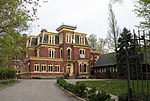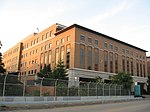Western Pennsylvania Hospital
Hospital buildings completed in 1909Hospitals established in 1848Hospitals in PennsylvaniaHospitals in PittsburghPittsburgh History & Landmarks Foundation Historic Landmarks

The Western Pennsylvania Hospital, commonly referred to as "West Penn Hospital", is located at 4800 Friendship Avenue in the Bloomfield neighborhood of Pittsburgh, Pennsylvania. The 317-bed hospital is part of the Allegheny Health Network. It serves as a Clinical Campus of Temple University School of Medicine, offering medical education, including a large number of residency and fellowship programs. It is also the primary clinical setting of the West Penn Hospital School of Nursing.
Excerpt from the Wikipedia article Western Pennsylvania Hospital (License: CC BY-SA 3.0, Authors, Images).Western Pennsylvania Hospital
Friendship Avenue, Pittsburgh
Geographical coordinates (GPS) Address Phone number Website External links Nearby Places Show on map
Geographical coordinates (GPS)
| Latitude | Longitude |
|---|---|
| N 40.461388888889 ° | E -79.946388888889 ° |
Address
Western Pennsylvania Hospital (West Penn Hospital)
Friendship Avenue 4800
15224 Pittsburgh
Pennsylvania, United States
Open on Google Maps









